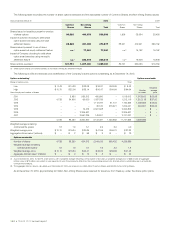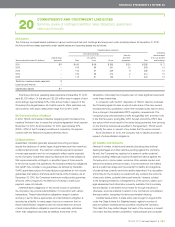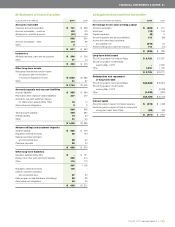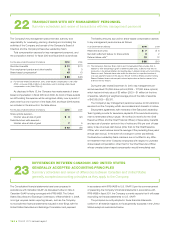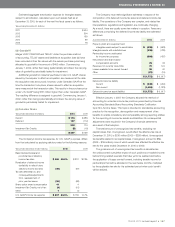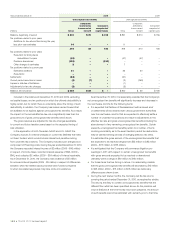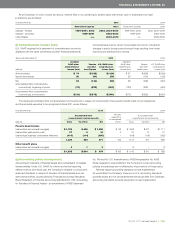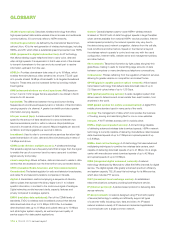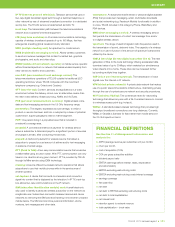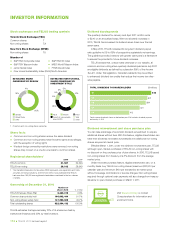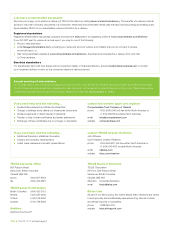Telus 2010 Annual Report Download - page 174
Download and view the complete annual report
Please find page 174 of the 2010 Telus annual report below. You can navigate through the pages in the report by either clicking on the pages listed below, or by using the keyword search tool below to find specific information within the annual report.170 . TELUS 2010 annual report
3G (third generation): Describes wireless technology that offers
high-speed packet data mobile wireless Internet access and multimedia
communications. 3G commonly refers to HSPA networks.
4G (fourth generation): As defined by the International Telecommuni-
cations Union, 4G is the next generation of wireless technologies, including
HSPA+ and LTE, which offers a substantial speed improvement over HSPA.
ADSL (asymmetric digital subscriber line): An IP technology
that allows existing copper telephone lines to carry voice, data and
video at high speeds. It is asymmetric in that it uses most of the channel
to transmit downstream to the user and only a small part to receive
information upstream from the user.
ADSL2+: Provides downstream data rates of up to 19 Mbps, which
enables three simultaneous video streams into a home. TELUS’ goal
is to provide
at least 15 Mbps of bandwidth to its targeted broadband
footprint. These
rates can be increased further by bonding multiple
lines together.
AWS (advanced wireless services) spectrum: AWS spectrum
in the 1.7 and 2.1 GHz ranges that are expected to be utilized in North
America for 4G services.
bandwidth: The difference between the top and bottom limiting
frequencies of a continuous frequency band, or indicator of the information-
carrying capacity of a channel. A greater bandwidth provides a greater
information-carrying capacity.
bits per second (bps): A measurement of data transmission
speed for the amount of data transferred in a second between two
telecommunications points or within a network. Kbps (kilobits per
second) is thousands of bits per second; Mbps (megabits per second)
is millions; and Gbps (gigabits per second) is billions.
broadband: Used to refer to communications services that allow high-
speed transmission of voice, data and video simultaneously at rates of
1.5 Mbps and above.
CDMA (code division multiple access): A wireless technology
that spreads a signal over a frequency band that is larger than the signal
to enable the use of a common band by many users and to achieve
signal security and privacy.
cloud computing: Allows software, data and services to reside in data
centres that are accessed over the Internet from any connected device.
CRTC (Canadian Radio-television and Telecommunications
Commission): The federal regulator for radio and television broadcasters,
and cable-TV and telecommunications companies in Canada.
digital: A transmission method employing a sequence of discrete,
distinct pulses that represent the binary digits 0 and 1 to indicate
specific information, in contrast to the continuous signal of analogue.
Digital networks provide improved clarity, capacity, features and
privacy compared to analogue systems.
EVDO (evolution data optimized): Part of the CDMA family of
standards, EVDO is wireless radio broadband protocol that delivers
data download rates of up to 2.4 Mbps. EVDO Rev A increases
data download rates up to 3.1 Mbps and upload rates up to 1.8 Mbps
and adds higher system capacity, as well as improved quality of
service support for data packet applications.
GLOSSARY
fastest: Canada’s fastest coast-to-coast HSPA+ wireless network
is based on TELUS’ tests of data throughput speeds in large Canadian
urban centres available from national HSPA+ service providers. Internet
access speed provided by the network operator may vary due to
the device being used, network congestion, distance from the cell site,
local conditions and other factors. Speed on the Internet is beyond
the wireless network operator’s control and may vary with the user’s
configuration, Internet traffic, website server and management policies,
and other factors.
fibre network: Transmits information by light pulses along hair-thin
glass fibres, making it useful for transmitting large amounts of data
between computers or many simultaneous telephone conversations.
forbearance: Policies refraining from the regulation of telecom services,
allowing for greater reliance on competition and market forces.
GPON (gigabit-capable passive optical network): A fibre-based
transmission technology that delivers data download rates of up to
2.5 Gbps and upload rates of up to 1.25 Gbps.
GPS (global positioning system): A radio navigation system that
allows users to determine and communicate their exact location, from
anywhere in the world.
GSM (global system for mobile communication): A digital PCS
mobile phone standard used in many parts of the world.
hosting: The management of data, which incorporates the business
of housing, serving and maintaining files for one or more websites.
hotspot: A Wi-Fi wireless access point in a public place.
HSPA+ (high-speed packet access): A 4G technology capable
of delivering advanced wireless data download speeds. HSPA+ network
technology is currently capable of delivering
manufacturer-rated wireless
data download speeds of up to
21 Mbps and upload speeds of up
to 5.8 Mbps.
HSPA+ dual-cell technology: A 4G technology that uses advanced
multiplexing techniques to combine two wireless data carriers, each
capable of delivering download speeds of up to 21 Mbps, into a single
carrier with manufacturer-rated download speeds of up to 42 Mbps
and upload speeds of up to 5.8 Mbps.
iDEN (integrated digital enhanced network): A network
technology developed by Motorola to utilize 800 MHz channels for digital
service. The digital signals offer greatly enhanced spectrum efficiency
and system capacity. TELUS uses this technology for its Mike service,
which also includes PTT service.
ILEC (incumbent local exchange carrier): An established
telecommunications company providing local telephone service.
IP (Internet protocol): A packet-based protocol for delivering data
across networks.
IP-based network: A network designed using IP and QoS (quality
of service) technology to reliably and efficiently support all types
of customer traffic including voice, data and video. An IP-based
network enables a variety of IP devices and advanced applications
to communicate over a single common network.


